Diffusion-Denoising Process with Gated U-Net for High-Quality Document Binarization
Abstract
:1. Introduction
- We propose a novel approach by redefining document binarization as an iterative diffusion-denoising problem for degraded document images. This is the first study to incorporate an LDM into document binarization to generate high-quality, clean, binarized document images.
- We use a gated convolution in the latent space for the precise extraction of text strokes. This approach simplifies the differentiation between the text and the background by continually updating the gating value as a guide for delineating the text region.
- The proposed model produces high-quality, clean, binarized document images and outperforms existing methods on multiple H-DIBCO datasets.
2. Related Works
2.1. Document Binarization
2.2. Diffusion Model for Image-to-Image Tasks
2.3. Gated Convolutions
3. Method
3.1. Preliminaries
3.2. Network Architecture
3.3. Document Diffusion-Denoising Network
3.3.1. Document Image Compression
3.3.2. Diffusion-Denoising Process
3.4. Gated U-Net in the Latent Space
4. Experiments and Results
4.1. Dataset and Implementation Details
4.2. Evaluation Metrics
4.3. Quantitative and Qualitative Comparison
4.4. Ablation Study
5. Conclusions
Author Contributions
Funding
Institutional Review Board Statement
Informed Consent Statement
Data Availability Statement
Conflicts of Interest
References
- Sulaiman, A.; Omar, K.; Nasrudin, M.F. Degraded historical document binarization: A review on issues, challenges, techniques, and future directions. J. Imaging 2019, 5, 48. [Google Scholar] [CrossRef] [PubMed]
- Farahmand, A.; Sarrafzadeh, H.; Shanbehzadeh, J. Document image noises and removal methods. In Proceedings of the International MultiConference of Engineers and Computer Scientists, Hong Kong, China, 21–23 March 2013. [Google Scholar]
- Mustafa, W.A.; Kader, M.M.M.A. Binarization of document images: A comprehensive review. J. Phys. Conf. Ser. 2018, 1019, 012023. [Google Scholar] [CrossRef]
- Chauhan, S.; Sharma, E.; Doegar, A. Binarization techniques for degraded document images—A review. In Proceedings of the 2016 5th International Conference on Reliability, Infocom Technologies and Optimization (Trends and Future Directions) (ICRITO), Noida, India, 7–9 September 2016; pp. 163–166. [Google Scholar]
- Sauvola, J.; Seppanen, T.; Haapakoski, S.; Pietikainen, M. Adaptive document binarization. In Proceedings of the Fourth International Conference on Document Analysis and Recognition, Ulm, Germany, 18–20 August 1997; Volume 1, pp. 147–152. [Google Scholar]
- Otsu, N. A threshold selection method from gray-level histograms. IEEE Trans. Syst. Man Cybern. 1979, 9, 62–66. [Google Scholar] [CrossRef]
- Niblack, W. An Introduction to Digital Image Processing; Strandberg Publishing Company: København, Denmark, 1985. [Google Scholar]
- He, S.; Schomaker, L. DeepOtsu: Document enhancement and binarization using iterative deep learning. Pattern Recognit. 2019, 91, 379–390. [Google Scholar] [CrossRef]
- Long, J.; Shelhamer, E.; Darrell, T. Fully convolutional networks for semantic segmentation. In Proceedings of the IEEE Conference on Computer Vision and Pattern Recognition, Boston, MA, USA, 7–12 June 2015; pp. 3431–3440. [Google Scholar]
- Ronneberger, O.; Fischer, P.; Brox, T. U-net: Convolutional networks for biomedical image segmentation. In Proceedings of the Medical Image Computing and Computer-Assisted Intervention–MICCAI 2015: 18th International Conference, Munich, Germany, 5–9 October 2015; Proceedings, Part III 18. Springer: Cham, Switzerland, 2015; pp. 234–241. [Google Scholar]
- Westphal, F.; Lavesson, N.; Grahn, H. Document image binarization using recurrent neural networks. In Proceedings of the 2018 13th IAPR International Workshop on Document Analysis Systems (DAS), Vienna, Austria, 24–27 April 2018; pp. 263–268. [Google Scholar]
- Tensmeyer, C.; Martinez, T. Document image binarization with fully convolutional neural networks. In Proceedings of the 2017 14th IAPR International Conference on Document Analysis and Recognition (ICDAR), Kyoto, Japan, 9–15 November 2017; Volume 1, pp. 99–104. [Google Scholar]
- Peng, X.; Wang, C.; Cao, H. Document Binarization via Multi-resolutional Attention Model with DRD Loss. In Proceedings of the 2019 International Conference on Document Analysis and Recognition (ICDAR), Sydney, Australia, 20–25 September 2019; pp. 45–50. [Google Scholar] [CrossRef]
- Huang, X.; Li, L.; Liu, R.; Xu, C.; Ye, M. Binarization of degraded document images with global-local U-Nets. Optik 2020, 203, 164025. [Google Scholar] [CrossRef]
- Zhao, J.; Shi, C.; Jia, F.; Wang, Y.; Xiao, B. Document image binarization with cascaded generators of conditional generative adversarial networks. Pattern Recognit. 2019, 96, 106968. [Google Scholar] [CrossRef]
- De, R.; Chakraborty, A.; Sarkar, R. Document image binarization using dual discriminator generative adversarial networks. IEEE Signal Process. Lett. 2020, 27, 1090–1094. [Google Scholar] [CrossRef]
- Souibgui, M.A.; Kessentini, Y. De-gan: A conditional generative adversarial network for document enhancement. IEEE Trans. Pattern Anal. Mach. Intell. 2020, 44, 1180–1191. [Google Scholar] [CrossRef]
- Suh, S.; Kim, J.; Lukowicz, P.; Lee, Y.O. Two-stage generative adversarial networks for binarization of color document images. Pattern Recognit. 2022, 130, 108810. [Google Scholar] [CrossRef]
- Dhariwal, P.; Nichol, A. Diffusion models beat gans on image synthesis. Adv. Neural Inf. Process. Syst. 2021, 34, 8780–8794. [Google Scholar]
- Rombach, R.; Blattmann, A.; Lorenz, D.; Esser, P.; Ommer, B. High-resolution image synthesis with latent diffusion models. In Proceedings of the IEEE/CVF Conference on Computer Vision and Pattern Recognition, New Orleans, LA, USA, 19–24 June 2022; pp. 10684–10695. [Google Scholar]
- Ho, J.; Jain, A.; Abbeel, P. Denoising diffusion probabilistic models. Adv. Neural Inf. Process. Syst. 2020, 33, 6840–6851. [Google Scholar]
- Yu, J.; Lin, Z.; Yang, J.; Shen, X.; Lu, X.; Huang, T.S. Free-form image inpainting with gated convolution. In Proceedings of the IEEE/CVF International Conference on Computer Vision, Seoul, Republic of Korea, 27 October–2 November 2019; pp. 4471–4480. [Google Scholar]
- Pratikakis, I.; Zagoris, K.; Barlas, G.; Gatos, B. ICFHR2016 handwritten document image binarization contest (H-DIBCO 2016). In Proceedings of the 2016 15th International Conference on Frontiers in Handwriting Recognition (ICFHR), Shenzhen, China, 23–26 October 2016; pp. 619–623. [Google Scholar]
- Pratikakis, I.; Zagoris, K.; Barlas, G.; Gatos, B. ICDAR2017 competition on document image binarization (DIBCO 2017). In Proceedings of the 2017 14th IAPR International Conference on Document Analysis and Recognition (ICDAR), Kyoto, Japan, 9–15 November 2017; Volume 1, pp. 1395–1403. [Google Scholar]
- Pratikakis, I.; Zagori, K.; Kaddas, P.; Gatos, B. ICFHR 2018 Competition on Handwritten Document Image Binarization (H-DIBCO 2018). In Proceedings of the 2018 16th International Conference on Frontiers in Handwriting Recognition (ICFHR), Niagara Falls, NY, USA, 5–8 August 2018; pp. 489–493. [Google Scholar] [CrossRef]
- Pratikakis, I.; Zagoris, K.; Karagiannis, X.; Tsochatzidis, L.; Mondal, T.; Marthot-Santaniello, I. ICDAR 2019 Competition on Document Image Binarization (DIBCO 2019). In Proceedings of the 2019 International Conference on Document Analysis and Recognition (ICDAR), Sydney, Australia, 20–25 September 2019; pp. 1547–1556. [Google Scholar] [CrossRef]
- Peng, X.; Cao, H.; Natarajan, P. Using convolutional encoder-decoder for document image binarization. In Proceedings of the 2017 14th IAPR international conference on document analysis and recognition (ICDAR), Kyoto, Japan, 9–15 November 2017; Volume 1, pp. 708–713. [Google Scholar]
- Calvo-Zaragoza, J.; Gallego, A.J. A selectional auto-encoder approach for document image binarization. Pattern Recognit. 2019, 86, 37–47. [Google Scholar] [CrossRef]
- Kang, S.; Iwana, B.K.; Uchida, S. Complex image processing with less data—Document image binarization by integrating multiple pre-trained U-Net modules. Pattern Recognit. 2021, 109, 107577. [Google Scholar] [CrossRef]
- Akbari, Y.; Al-Maadeed, S.; Adam, K. Binarization of degraded document images using convolutional neural networks and wavelet-based multichannel images. IEEE Access 2020, 8, 153517–153534. [Google Scholar] [CrossRef]
- Isola, P.; Zhu, J.Y.; Zhou, T.; Efros, A.A. Image-to-image translation with conditional adversarial networks. In Proceedings of the IEEE Conference on Computer Vision and Pattern Recognition, Honolulu, HI, USA, 21–26 July 2017; pp. 1125–1134. [Google Scholar]
- Lin, Y.S.; Ju, R.Y.; Chen, C.C.; Lin, T.Y.; Chiang, J.S. Three-stage binarization of color document images based on discrete wavelet transform and generative adversarial networks. arXiv 2022, arXiv:2211.16098. [Google Scholar]
- Song, J.; Meng, C.; Ermon, S. Denoising diffusion implicit models. arXiv 2020, arXiv:2010.02502. [Google Scholar]
- Wolleb, J.; Sandkühler, R.; Bieder, F.; Valmaggia, P.; Cattin, P.C. Diffusion models for implicit image segmentation ensembles. In Proceedings of the International Conference on Medical Imaging with Deep Learning, PMLR, Zurich, Switzerland, 6–8 July 2022; pp. 1336–1348. [Google Scholar]
- Kim, B.; Oh, Y.; Ye, J.C. Diffusion adversarial representation learning for self-supervised vessel segmentation. arXiv 2022, arXiv:2209.14566. [Google Scholar]
- Chen, S.; Sun, P.; Song, Y.; Luo, P. Diffusiondet: Diffusion model for object detection. arXiv 2022, arXiv:2211.09788. [Google Scholar]
- Duan, Y.; Guo, X.; Zhu, Z. Diffusiondepth: Diffusion denoising approach for monocular depth estimation. arXiv 2023, arXiv:2303.05021. [Google Scholar]
- Li, X.; Zhao, H.; Han, L.; Tong, Y.; Tan, S.; Yang, K. Gated fully fusion for semantic segmentation. In Proceedings of the AAAI Conference on Artificial Intelligence, New York, NY, USA, 7–12 February 2020; Volume 34, pp. 11418–11425. [Google Scholar]
- Wang, H.; Wang, Y.; Zhang, Q.; Xiang, S.; Pan, C. Gated convolutional neural network for semantic segmentation in high-resolution images. Remote Sens. 2017, 9, 446. [Google Scholar] [CrossRef]
- Dauphin, Y.N.; Fan, A.; Auli, M.; Grangier, D. Language modeling with gated convolutional networks. In Proceedings of the International Conference on Machine Learning, PMLR, Sydney, Australia, 6–11 August 2017; pp. 933–941. [Google Scholar]
- Lin, X.; Ma, L.; Liu, W.; Chang, S.F. Context-gated convolution. In Proceedings of the Computer Vision–ECCV 2020: 16th European Conference, Glasgow, UK, 23–28 August 2020; Proceedings, Part XVIII 16. Springer: Cham, Switzerland, 2020; pp. 701–718. [Google Scholar]
- Zhang, Y.; Fang, J.; Chen, Y.; Jia, L. Edge-aware U-net with gated convolution for retinal vessel segmentation. Biomed. Signal Process. Control 2022, 73, 103472. [Google Scholar] [CrossRef]
- Kwon, M.; Jeong, J.; Uh, Y. Diffusion models already have a semantic latent space. arXiv 2022, arXiv:2210.10960. [Google Scholar]
- Esser, P.; Rombach, R.; Ommer, B. Taming transformers for high-resolution image synthesis. In Proceedings of the IEEE/CVF Conference on Computer Vision and Pattern Recognition, Nashville, TN, USA, 20–25 June 2021; pp. 12873–12883. [Google Scholar]
- Pratikakis, I.; Gatos, B.; Ntirogiannis, K. H-DIBCO 2010-handwritten document image binarization competition. In Proceedings of the 2010 12th International Conference on Frontiers in Handwriting Recognition, Kolkata, India, 16–18 November 2010; pp. 727–732. [Google Scholar]
- Pratikakis, I.; Gatos, B.; Ntirogiannis, K. ICFHR 2012 competition on handwritten document image binarization (H-DIBCO 2012). In Proceedings of the 2012 International Conference on Frontiers in Handwriting Recognition, Bari, Italy, 18–20 September 2012; pp. 817–822. [Google Scholar]
- Ntirogiannis, K.; Gatos, B.; Pratikakis, I. ICFHR2014 competition on handwritten document image binarization (H-DIBCO 2014). In Proceedings of the 2014 14th International Conference on Frontiers in Handwriting Recognition, Hersonissos, Greece, 1–4 September 2014; pp. 809–813. [Google Scholar]
- Gatos, B.; Ntirogiannis, K.; Pratikakis, I. ICDAR 2009 document image binarization contest (DIBCO 2009). In Proceedings of the 2009 10th International Conference on Document Analysis and Recognition, Barcelona, Spain, 26–29 July 2009; pp. 1375–1382. [Google Scholar]
- Pratikakis, I.; Gatos, B.; Ntirogiannis, K. ICDAR 2011 Document Image Binarization Contest (DIBCO 2011). In Proceedings of the 2011 International Conference on Document Analysis and Recognition, Beijing, China, 18–21 September 2011; pp. 1506–1510. [Google Scholar] [CrossRef]
- Pratikakis, I.; Gatos, B.; Ntirogiannis, K. ICDAR 2013 document image binarization contest (DIBCO 2013). In Proceedings of the 2013 12th International Conference on Document Analysis and Recognition, Washington, DC, USA, 25–28 August 2013; pp. 1471–1476. [Google Scholar]
- Deng, F.; Wu, Z.; Lu, Z.; Brown, M.S. Binarizationshop: A user-assisted software suite for converting old documents to black-and-white. In Proceedings of the 10th Annual Joint Conference on Digital Libraries, Gold Coast, Australia, 21 June 2010; pp. 255–258. [Google Scholar]
- Nafchi, H.Z.; Ayatollahi, S.M.; Moghaddam, R.F.; Cheriet, M. An efficient ground truthing tool for binarization of historical manuscripts. In Proceedings of the 2013 12th International Conference on Document Analysis and Recognition, Washington, DC, USA, 25–28 August 2013; pp. 807–811. [Google Scholar]
- Hedjam, R.; Cheriet, M. Historical document image restoration using multispectral imaging system. Pattern Recognit. 2013, 46, 2297–2312. [Google Scholar] [CrossRef]
- Loshchilov, I.; Hutter, F. Decoupled weight decay regularization. arXiv 2017, arXiv:1711.05101. [Google Scholar]
- Ntirogiannis, K.; Gatos, B.; Pratikakis, I. Performance evaluation methodology for historical document image binarization. IEEE Trans. Image Process. 2012, 22, 595–609. [Google Scholar] [CrossRef]
- Lu, H.; Kot, A.C.; Shi, Y.Q. Distance-reciprocal distortion measure for binary document images. IEEE Signal Process. Lett. 2004, 11, 228–231. [Google Scholar] [CrossRef]

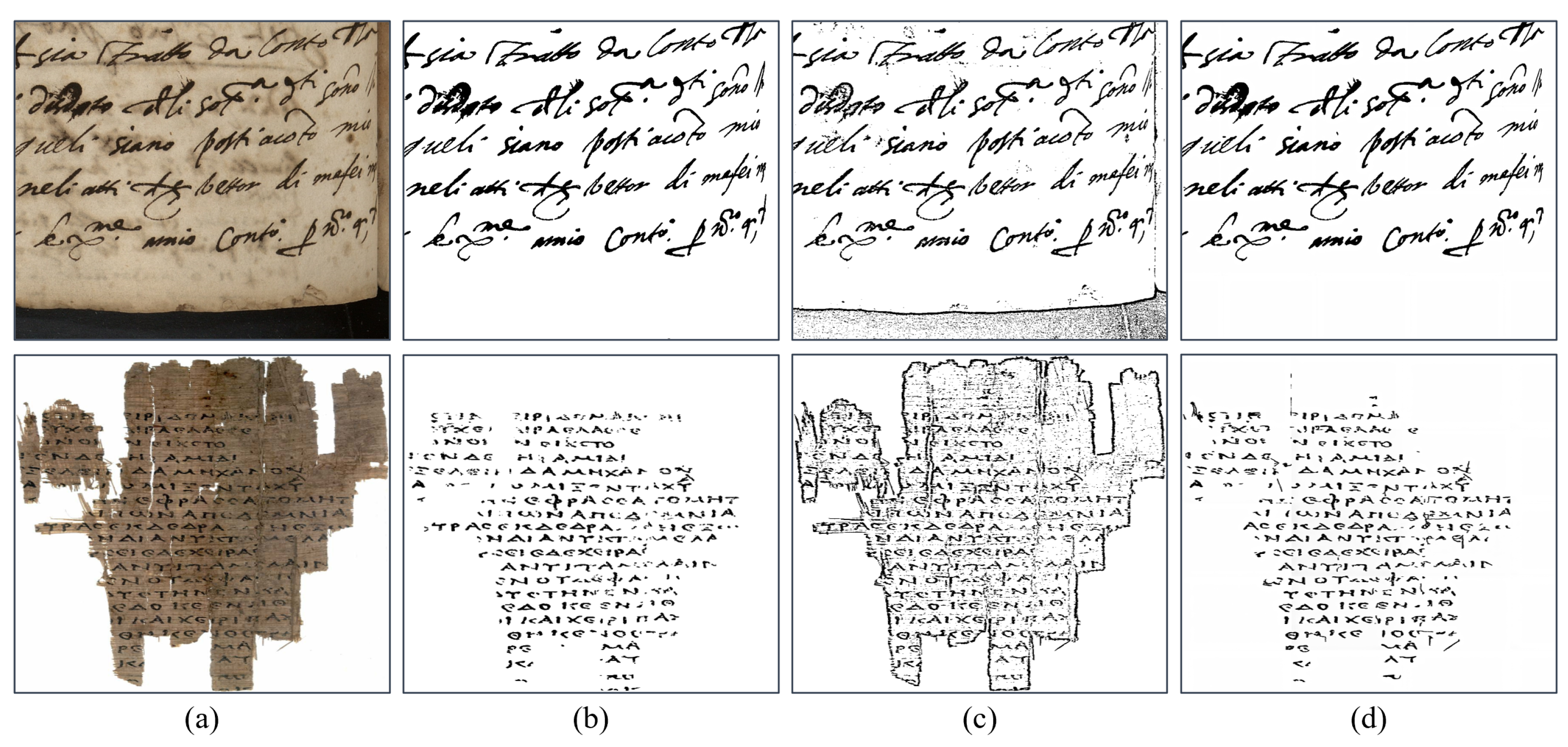
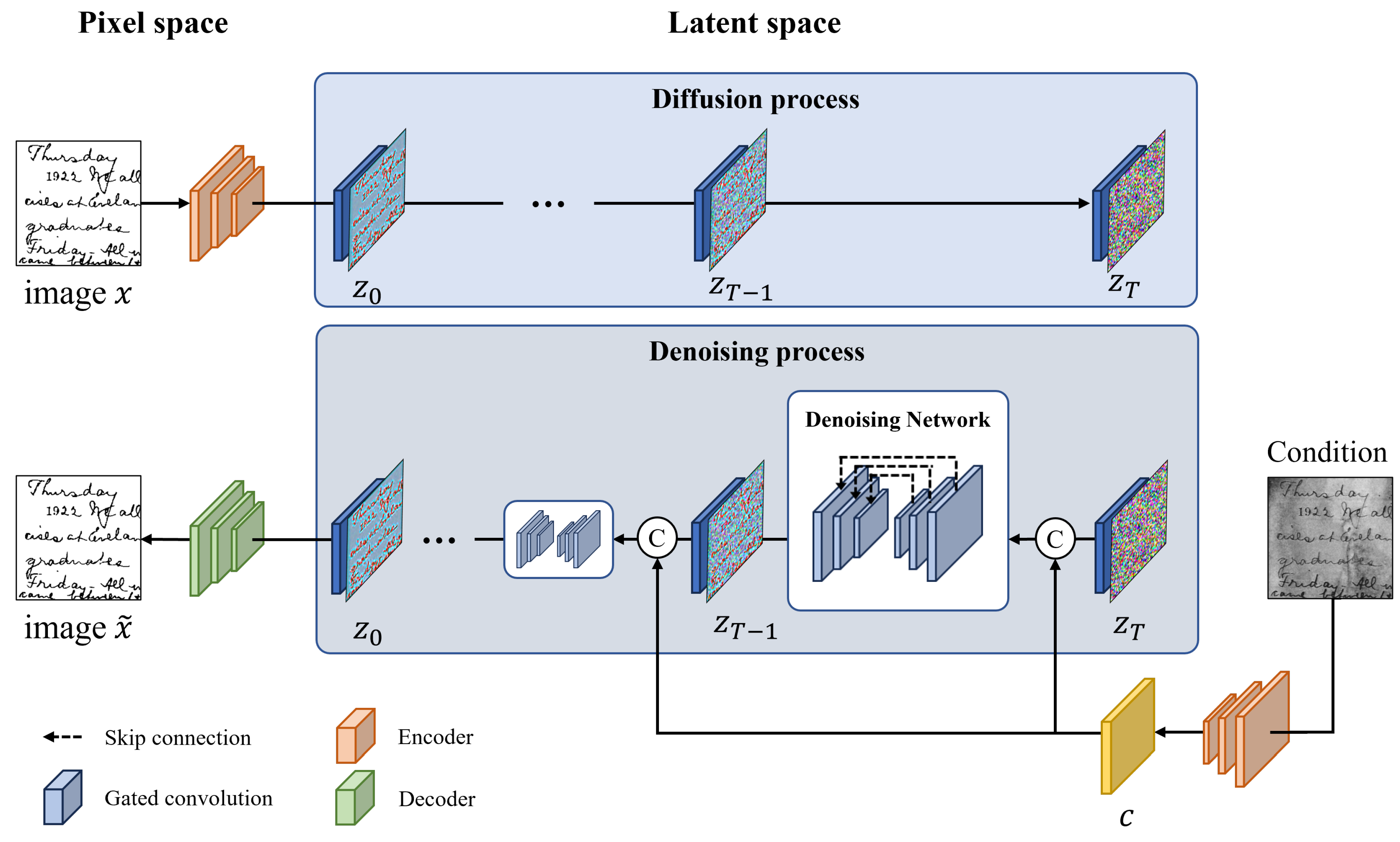
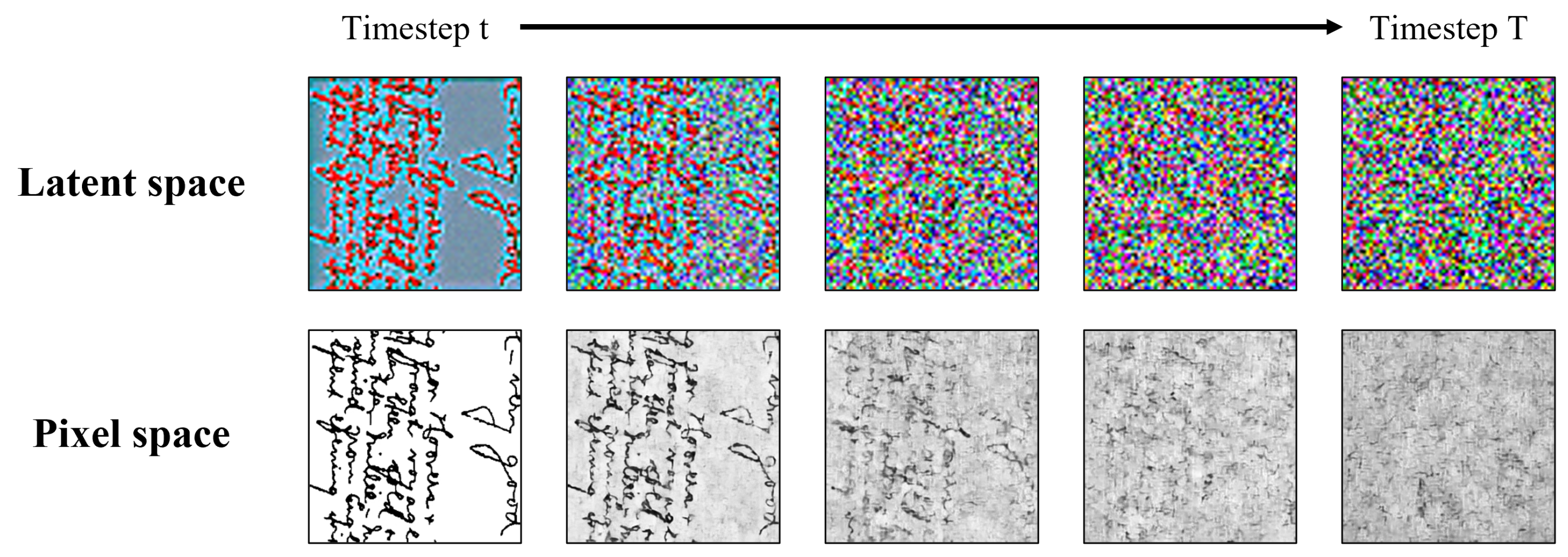
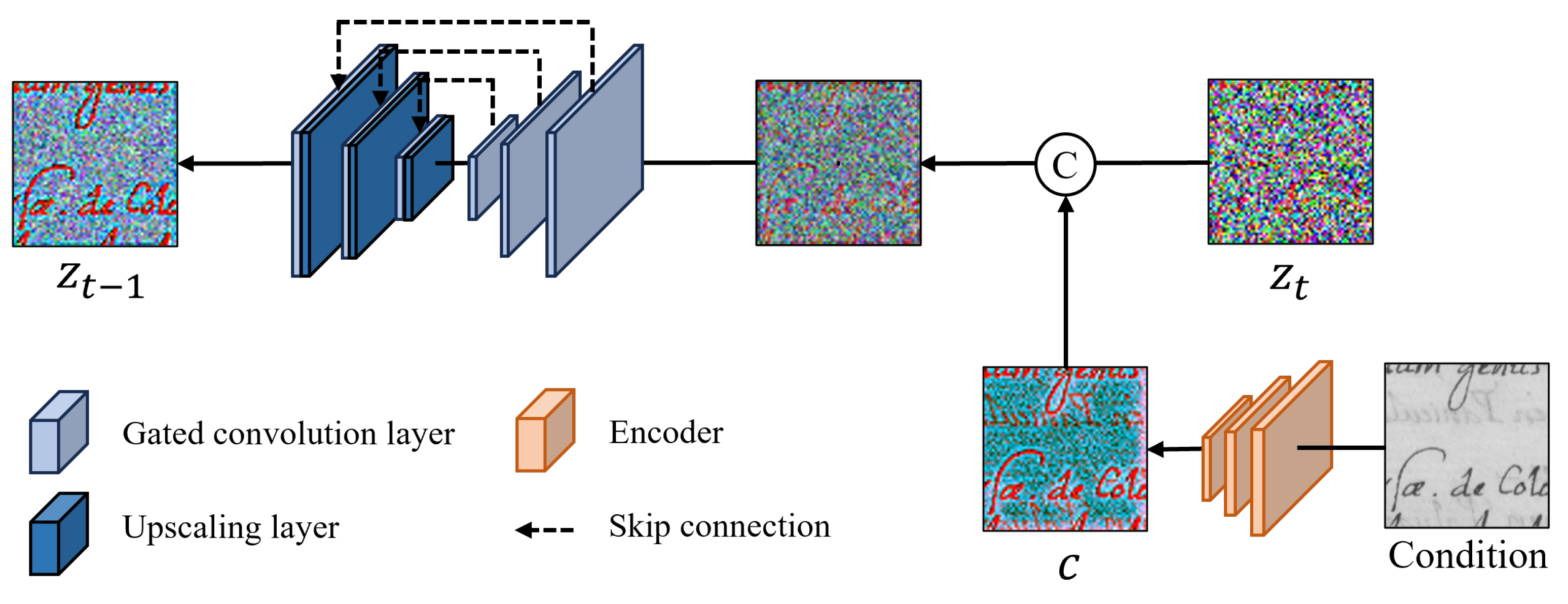
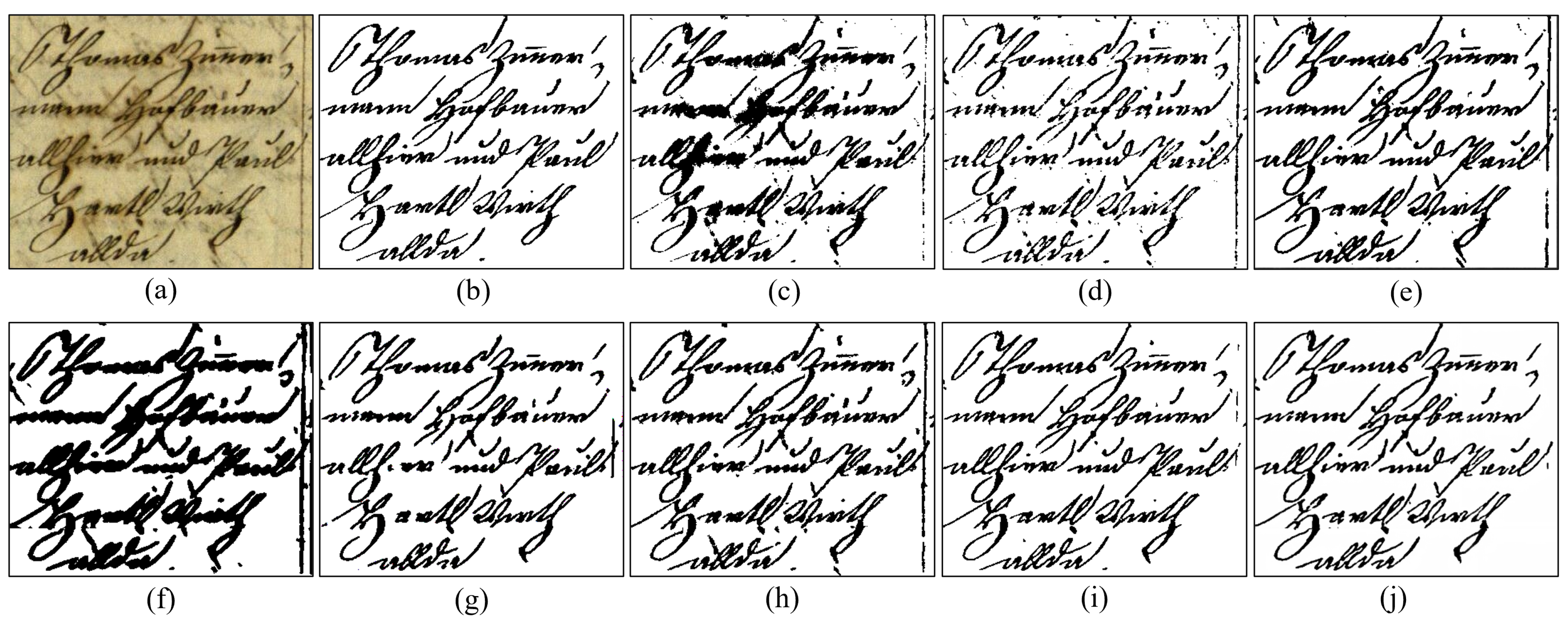
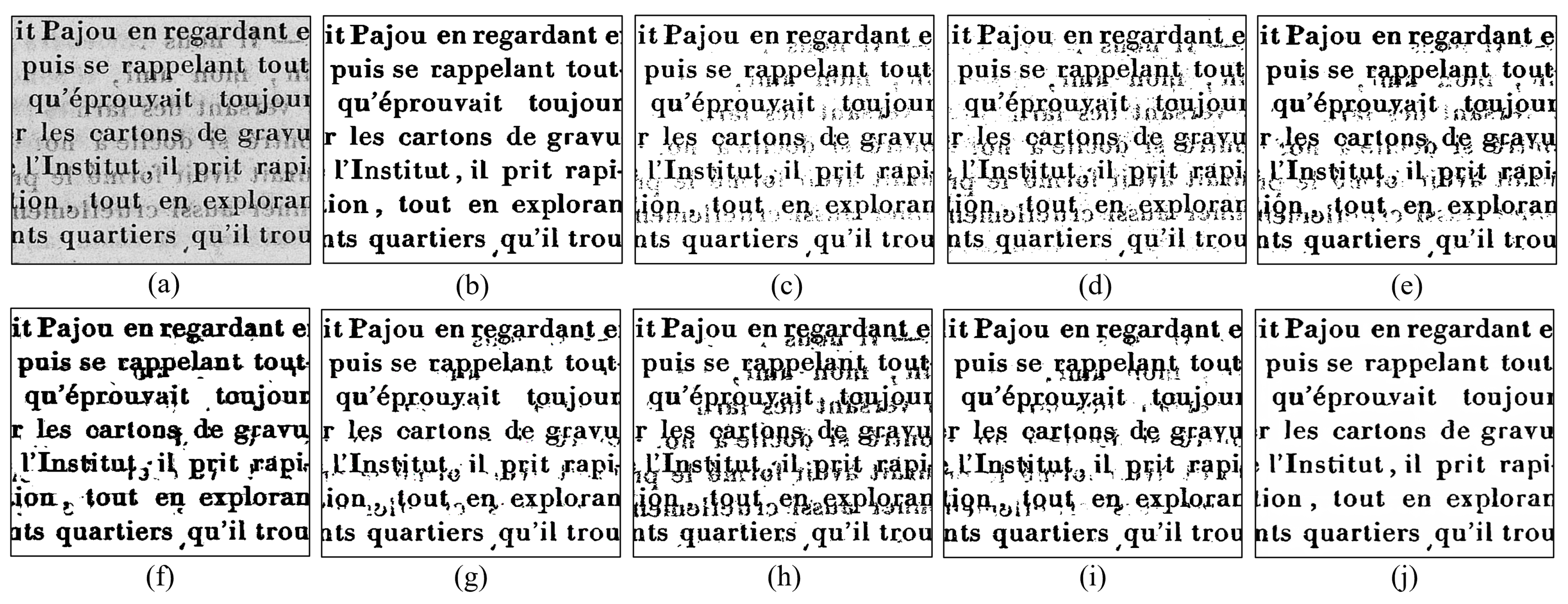
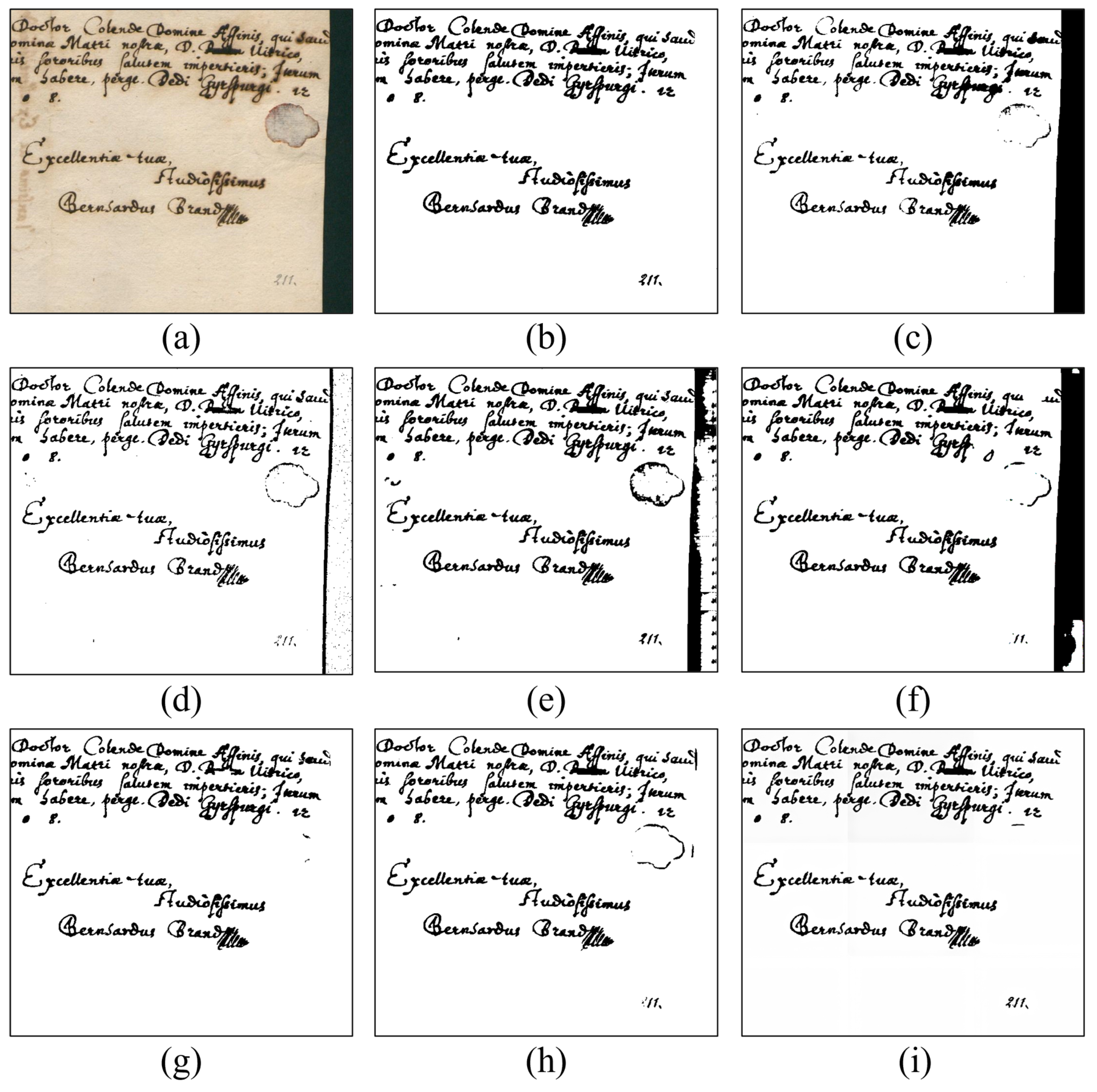
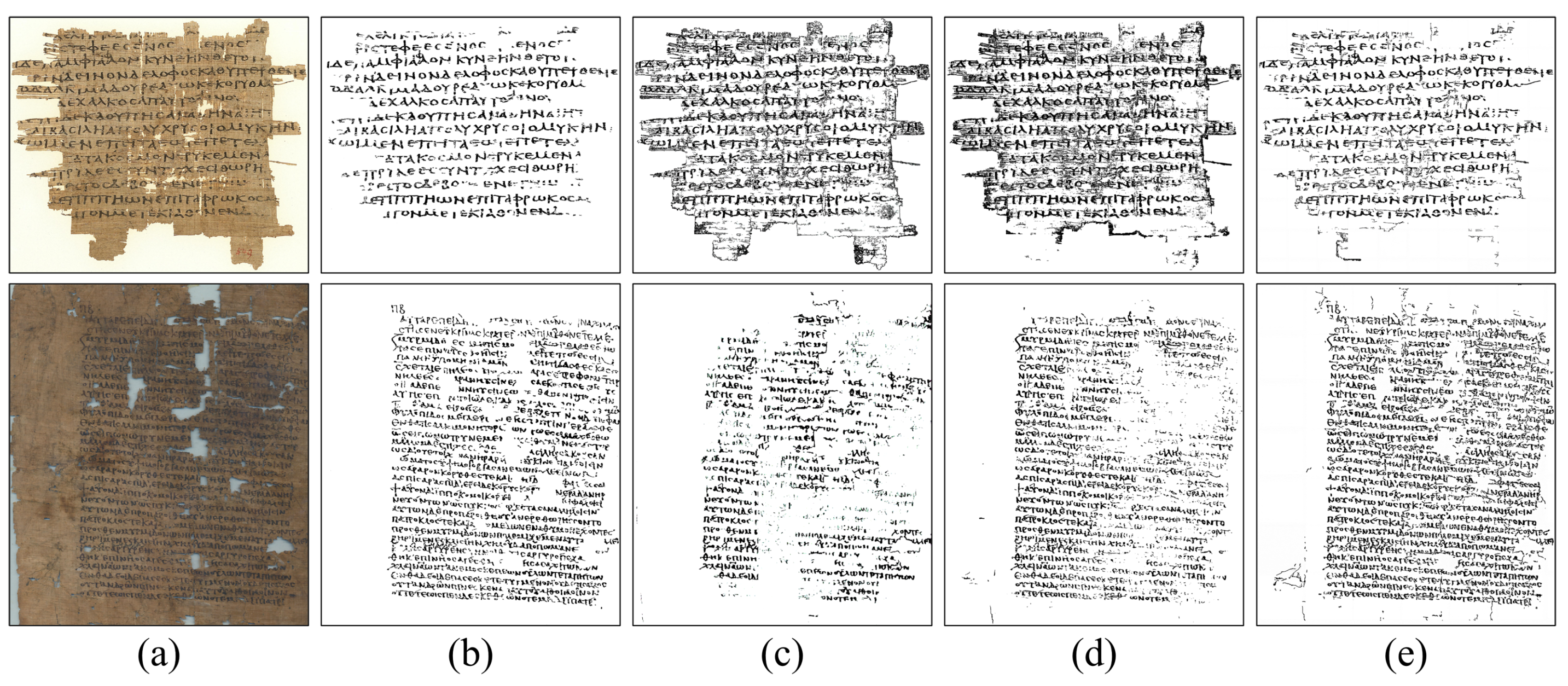

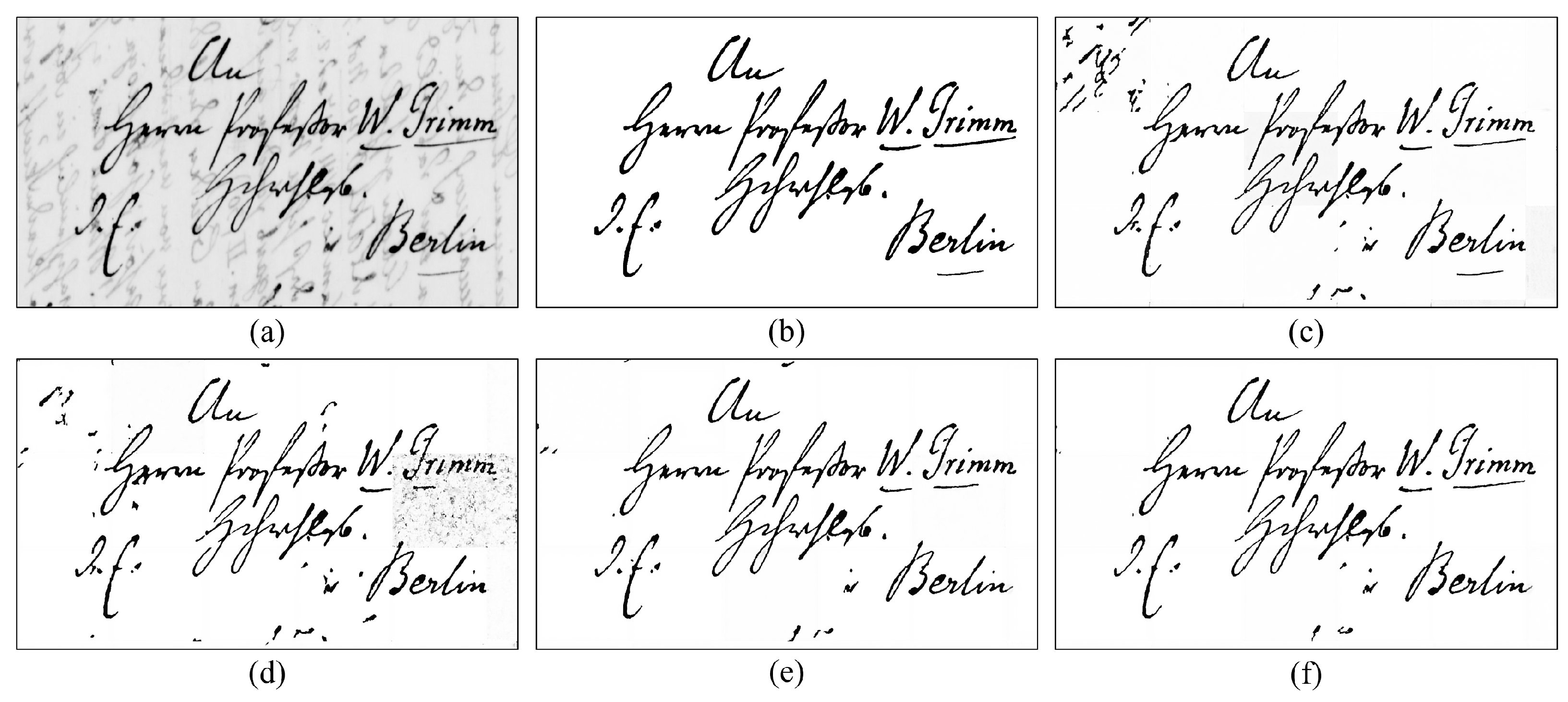
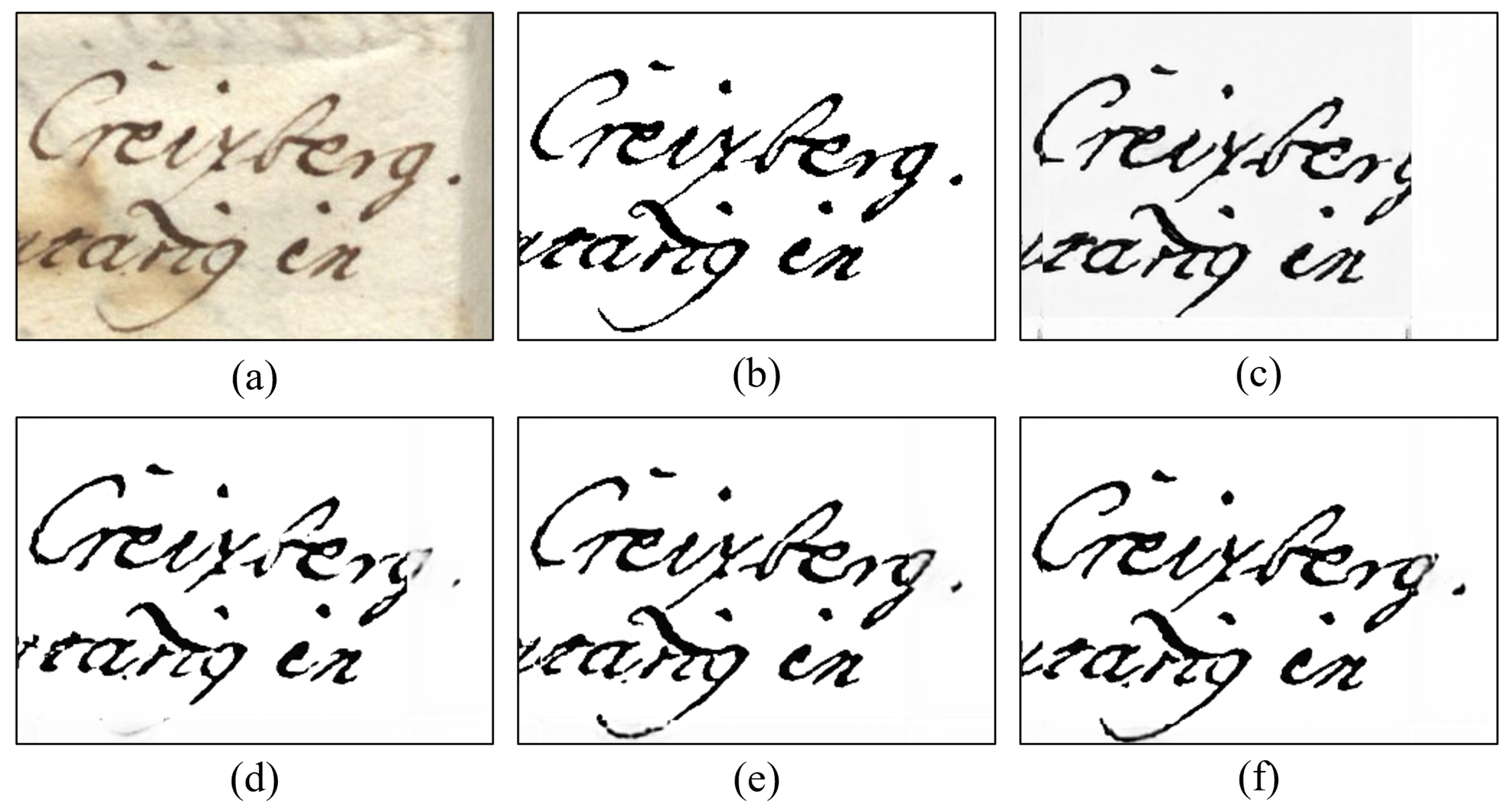
| Dataset | Metric | Otsu [6] | Sauvola [5] | Competition Winner | SAE [28] | cGANs [15] | Akbari [30] | Souibgui [17] | Suh [18] | Ours |
|---|---|---|---|---|---|---|---|---|---|---|
| 2016 | FM | 86.64 | 79.57 | 88.72 | 88.11 | 91.67 | 90.48 | 84.45 | 91.11 | 88.95 |
| pFM | 89.99 | 86.84 | 91.84 | 91.55 | 94.59 | 93.26 | 84.73 | 95.22 | 95.45 | |
| PSNR | 17.80 | 16.90 | 18.45 | 18.21 | 19.64 | 19.27 | 16.18 | 19.34 | 19.38 | |
| DRD | 5.52 | 6.76 | 3.86 | 4.51 | 2.82 | 3.94 | 7.25 | 3.25 | 3.74 | |
| 2017 | FM | 80.63 | 73.86 | 91.04 | 85.72 | 90.73 | 85.59 | 80.63 | 89.33 | 89.36 |
| pFM | 80.85 | 84.78 | 92.86 | 87.85 | 92.58 | 87.56 | 80.85 | 91.41 | 94.02 | |
| PSNR | 13.84 | 14.30 | 18.28 | 16.09 | 17.83 | 16.39 | 13.84 | 17.91 | 18.33 | |
| DRD | 9.85 | 8.30 | 3.40 | 6.53 | 3.58 | 7.99 | 9.85 | 3.83 | 3.83 | |
| 2018 | FM | 51.56 | 64.04 | 88.34 | 75.77 | 87.73 | 76.51 | 77.59 | 91.86 | 88.43 |
| pFM | 53.58 | 72.13 | 90.24 | 77.95 | 90.60 | 80.09 | 85.74 | 96.25 | 93.73 | |
| PSNR | 9.76 | 13.98 | 19.11 | 14.79 | 18.37 | 17.01 | 16.16 | 20.03 | 19.28 | |
| DRD | 59.07 | 13.96 | 4.92 | 13.30 | 4.58 | 8.11 | 7.93 | 2.60 | 3.95 | |
| 2019-B | FM | 22.47 | 50.57 | 67.99 | 47.57 | 61.64 | 47.00 | 49.83 | 66.83 | 72.71 |
| pFM | 22.47 | 54.48 | 67.88 | 48.55 | 62.52 | 47.60 | 49.97 | 68.32 | 75.24 | |
| PSNR | 2.61 | 10.85 | 12.14 | 10.84 | 11.77 | 9.18 | 8.55 | 12.91 | 14.37 | |
| DRD | 213.58 | 33.73 | 26.87 | 32.00 | 24.11 | 70.50 | 53.18 | 19.80 | 14.39 | |
| Mean Values | FM | 59.61 | 67.01 | 84.02 | 74.29 | 82.94 | 74.90 | 71.64 | 84.78 | 84.86 |
| pFM | 61.53 | 74.56 | 85.71 | 76.47 | 85.07 | 77.13 | 71.85 | 87.80 | 89.61 | |
| PSNR | 11.01 | 14.01 | 17.00 | 14.98 | 16.90 | 15.46 | 12.86 | 17.55 | 17.84 | |
| DRD | 73.42 | 15.69 | 9.76 | 14.09 | 8.77 | 22.65 | 23.43 | 7.37 | 6.48 |
| H-DIBCO 2016 | FM | pFM | PSNR | DRD |
|---|---|---|---|---|
| Baseline | 88.25 | 94.44 | 19.09 | 4.05 |
| Ours w/o | 88.13 | 95.03 | 19.08 | 4.05 |
| Ours w/o Gated U-Net | 88.48 | 95.03 | 19.08 | 3.93 |
| Ours | 88.93 | 95.44 | 19.37 | 3.74 |
| H-DIBCO 2016/epoch 6 | FM | pFM |
|---|---|---|
| Baseline | 77.93 | 85.66 |
| Ours w/o | 79.53 | 85.84 |
| Ours w/o Gated U-Net | 85.93 | 93.60 |
| Ours | 86.15 | 94.17 |
Disclaimer/Publisher’s Note: The statements, opinions and data contained in all publications are solely those of the individual author(s) and contributor(s) and not of MDPI and/or the editor(s). MDPI and/or the editor(s) disclaim responsibility for any injury to people or property resulting from any ideas, methods, instructions or products referred to in the content. |
© 2023 by the authors. Licensee MDPI, Basel, Switzerland. This article is an open access article distributed under the terms and conditions of the Creative Commons Attribution (CC BY) license (https://creativecommons.org/licenses/by/4.0/).
Share and Cite
Han, S.; Ji, S.; Rhee, J. Diffusion-Denoising Process with Gated U-Net for High-Quality Document Binarization. Appl. Sci. 2023, 13, 11141. https://doi.org/10.3390/app132011141
Han S, Ji S, Rhee J. Diffusion-Denoising Process with Gated U-Net for High-Quality Document Binarization. Applied Sciences. 2023; 13(20):11141. https://doi.org/10.3390/app132011141
Chicago/Turabian StyleHan, Sangkwon, Seungbin Ji, and Jongtae Rhee. 2023. "Diffusion-Denoising Process with Gated U-Net for High-Quality Document Binarization" Applied Sciences 13, no. 20: 11141. https://doi.org/10.3390/app132011141
APA StyleHan, S., Ji, S., & Rhee, J. (2023). Diffusion-Denoising Process with Gated U-Net for High-Quality Document Binarization. Applied Sciences, 13(20), 11141. https://doi.org/10.3390/app132011141






